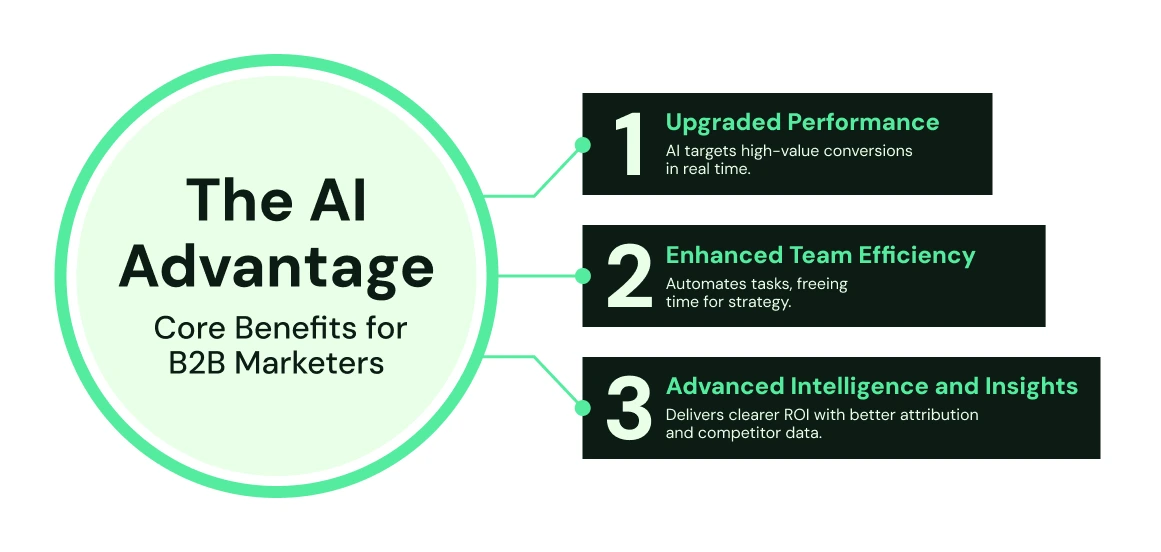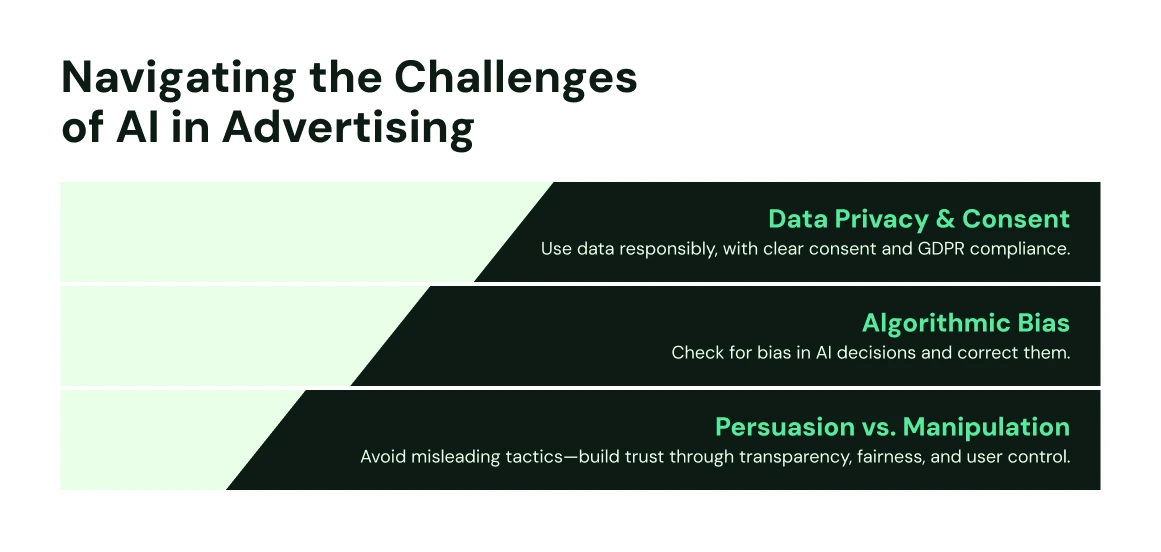August 25, 2025
|13 minute read

For years, the B2B paid advertising world has been a complex arena of human intuition, deep industry knowledge, and the kind of inspired copywriting that connects with a skeptical buying committee.
It’s been a realm where long sales cycles and relationship-building danced a delicate tango with the need for measurable Return on Investment (ROI). The perfect campaign felt like a lightning strike of strategic genius.
But a new force is rewriting the rules of this arena, and it’s doing so with the silent, relentless efficiency of a million minds working in unison. That force is Artificial Intelligence (AI), and its arrival has sparked a firestorm of debate.
Is this the dawn of a new golden age of B2B advertising, one of unprecedented precision and personalization? Or is it an “ad-pocalypse,” a moment where the strategic soul of marketing is being outsourced to unfeeling algorithms, turning seasoned professionals into mere machine minders?
The truth, as it often is, is far more complex and fascinating. The rise of AI in paid advertising is not a simple story of replacement, but one of radical transformation.
It’s a narrative about augmenting human capabilities, automating the monotonous, and unlocking a level of strategic depth that was previously unimaginable.
A recent McKinsey study found that generative AI alone could add the equivalent of trillions of dollars in value to the global economy, with marketing being one of the functions with the highest potential impact (McKinsey & Company, “The Economic Potential of Generative AI”).
For B2B marketers willing to adapt, AI is not a threat; it’s the most powerful tool ever placed in their hands.
This article will cut through the hype and the fear to deliver a clear-eyed analysis of the revolution at hand. We will explore how AI is fundamentally reshaping every facet of paid media, from audience targeting to ethical governance, and provide the actionable insights you need to master this new landscape.
For decades, B2B audience targeting was a game of educated guesses. Marketers relied on broad firmographics—company size, industry, job titles, and contextual clues to find their ideal customers.
AI has shattered this paradigm, replacing broad strokes with microscopic precision.
By leveraging machine learning (ML), AI algorithms can analyze vast datasets of user behavior, content downloads, webinar attendance, on-site interactions, and even competitor research to build nuanced and dynamic audience profiles.
This goes far beyond simple segmentation; AI creates what are known as “predictive audiences.”
These are groups of individuals and companies who, based on their digital body language, are statistically likely to have a purchasing need in the near future. This represents a fundamental shift from manually targeting static job titles to targeting dynamic user intent, a much more fluid and accurate approach.
They enable advertisers to reach a more relevant audience, leading to higher-quality leads and a significant reduction in wasted ad spend.
This ability to predict business-buyer behavior is not just a marginal improvement; it’s a quantum leap in advertising effectiveness.
Among all the ways AI is transforming B2B advertising, its influence on creativity is perhaps the most debated. For many marketers, the thought of AI writing copy or generating visuals can seem impersonal, even sterile. But in practice, AI is proving to be a powerful creative co-pilot, not a replacement for human insight.
In B2B, where complex buying decisions involve multiple stakeholders—from IT managers to CFOs—effective communication requires tailored messaging across personas and channels. Crafting and testing these messages at scale has historically drained resources. Now, AI is stepping in to handle the heavy lifting, while marketers focus on strategy, voice, and differentiation.
AI excels at producing countless combinations of ad copy variations—headlines, CTAs, descriptions—based on targeting criteria. This enables marketers to run rapid A/B tests across segments and buying stages.
Google’s Responsive Search Ads (RSA), for example, automatically mix and match different headline and description inputs to identify the best-performing combinations for specific audience groups.
This approach doesn’t replace human creativity; it enhances it by ensuring your best ideas are tested, refined, and scaled with precision.
Visual storytelling has become central to digital advertising, even in B2B. Generative AI tools now allow advertisers to create compelling, context-specific visuals from simple text prompts. For instance, a logistics brand might generate campaign visuals using a prompt like: “Create a professional image of a secure, temperature-controlled pharmaceutical supply chain in a modern warehouse.”
Instead of commissioning an expensive photo shoot, marketers can now rapidly create, test, and iterate campaign visuals across industries and geographies, cutting costs without compromising quality.
AI also powersDynamic Creative Optimization (DCO), a breakthrough in creative personalization. With DCO, a single ad template can serve multiple audiences by dynamically swapping out images, copy, and calls-to-action in real-time, based on user behavior, location, industry, or even job title.
In Account-Based Marketing (ABM) campaigns, this is especially powerful. For example:
This hyper-personalization, once a dream, is now scalable, driving higher engagement, relevance, and lead quality.
The value of AI-enabled personalization is backed by data. According to a McKinsey & Company report,companies drive 40% more revenue from personalized marketing efforts.
In B2B, where attention is hard-won and relationships matter, relevance is everything. AI gives marketers the ability to move from generalized messaging to moment-specific, persona-tailored engagement—at scale, without sacrificing quality.

AI improves campaign efficiency by learning from historical performance and optimizing delivery based on the likelihood to convert. Tools like Google’s Smart Bidding and Meta’s Advantage+ use predictive modeling to maximize outcomes at scale. By analyzing millions of signals in real-time, the AI can predict which clicks will be most valuable, focusing your budget where it will have the greatest impact.
Perhaps the greatest advantage of AI is that it liberates your team from repetitive, manual tasks. According to Salesforce’s “State of Marketing” report, high-performing marketers estimate that AI saves them an average of over five hours per week, time that can be reinvested into strategy, creativity, and customer relationships (Salesforce). AI handles bid adjustments, A/B testing, and budget allocation, allowing your team to focus on high-impact work that drives real business growth.
AI tools can benchmark your campaigns against competitors’, analyzing their spend patterns and placements. Furthermore, AI-driven attribution models move beyond simplistic “last-click” analysis to assign value across the entire B2B buyer journey, providing a truer picture of ROI.
AI is a powerful tool, but it is not a magic wand. To unlock its full potential, B2B organizations must have a solid foundation in place. Without these prerequisites, even the most advanced AI will fail to deliver meaningful results.
The applications of AI in B2B advertising are no longer theoretical. Here are some of the most powerful and widely used tools and tactics that are delivering results today.
For all its power, the rise of AI in advertising is not without its perils. B2B marketers must be particularly vigilant about maintaining trust with professional audiences.

Prepare for the Search Generative Experience (SGE): Google’s new AI-powered search experience will prioritize detailed, helpful content. To prepare, focus on optimizing your website’s solution pages with authoritative information that directly answers your customers’ key questions.
Start with one AI-Driven Bidding Strategy: Don’t try to do everything at once. Pick one campaign and switch from manual bidding to an automated strategy like “Maximize Conversions” or “Target CPA.” Set clear goals and let it run. This is a low-risk way to see the impact of AI.
Audit and Unify Your Data Foundation: Before you can effectively use AI, you need to trust your data. Ensure your conversion tracking is accurate, your CRM data is clean, and your privacy policies are up-to-date. The quality of your inputs will directly determine the quality of your outputs.
Combine Human Creativity with AI Scaling: Use generative AI to create a dozen variations of an ad headline. Then, have your expert human copywriter review, refine, and select the top three to test. This combines the scale of AI with the nuance of human expertise.
Use Your Customer List to Build a Lookalike Audience: This is one of the quickest and most powerful wins in AI advertising. Export a list of your best customers from your CRM and upload it to a platform like LinkedIn or Meta to find new, highly qualified prospects.
AI enhances lead quality by analyzing vast datasets to identify high-intent prospects. Tools like predictive lead scoring assess factors such as firmographics, engagement history, and behavior patterns to prioritize leads more likely to convert.
AI enables personalization by dynamically adjusting ad content based on user data. Dynamic Creative Optimization (DCO) allows for real-time customization of ads, tailoring messages to specific industries, job roles, or even individual companies.
Yes, AI enhances ABM by analyzing data to identify target accounts, personalize outreach, and optimize engagement strategies, leading to more effective and efficient campaigns.
Challenges include data integration complexities, the need for staff training, and ensuring the quality and consistency of AI-generated content.
AI can significantly improve ROI by optimizing ad spend, enhancing targeting precision, and increasing conversion rates through personalized content and predictive analytics.
Emerging trends include the rise of conversational AI for customer engagement, increased use of AI in video content creation, and the integration of AI with other technologies like augmented reality for immersive marketing experiences.
A: Poor data practices. Using inaccurate, biased, or non-consensual data can severely damage brand trust and lead to flawed campaign performance. Ethical and high-quality data handling is non-negotiable.
The journey of AI in paid advertising is just beginning. What seems revolutionary today will be standard practice tomorrow. The advertisers who will thrive in this new era are not those who fear the machine, but those who learn to dance with it. The “ad-pocalypse,” it turns out, isn’t an ending at all—it’s the beginning of a more intelligent, more effective, and ultimately, more human-centric era of B2B advertising. The future doesn’t belong to the machines; it belongs to the marketers who learn to master them.
Works Cited
Please enter your email address so we can send you a one-time pass code and verify if you are an existing subscriber.